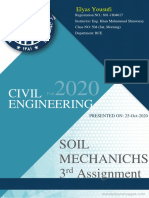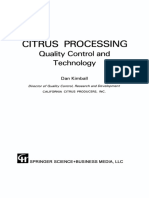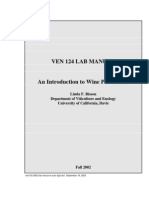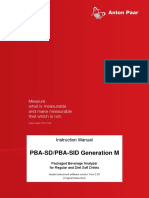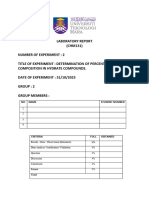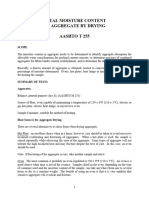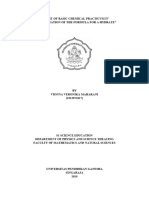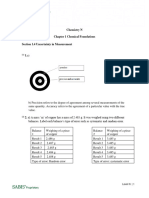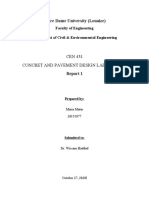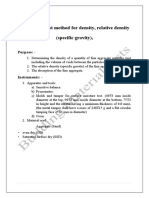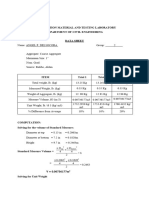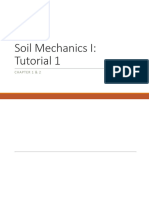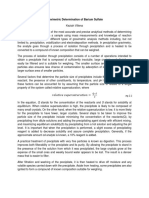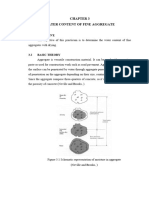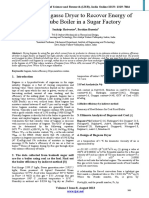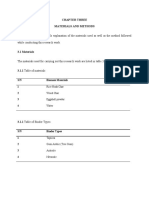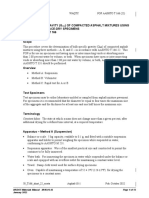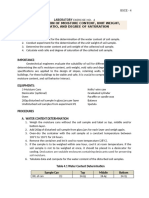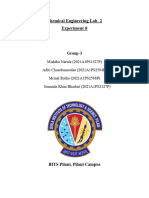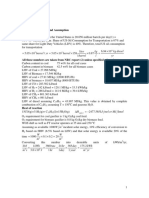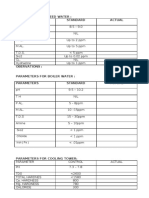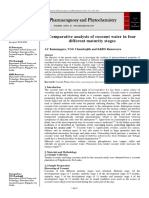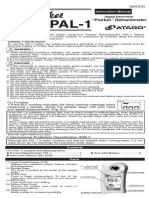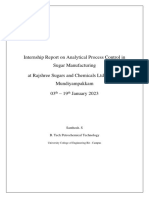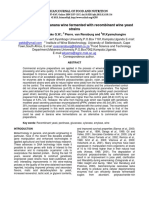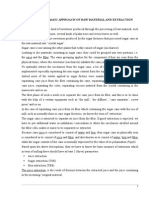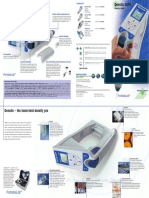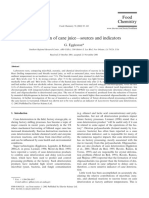6.2.3 Cane Calorific Value
6.2.3 Cane Calorific Value
Uploaded by
jagjitCopyright:
Available Formats
6.2.3 Cane Calorific Value
6.2.3 Cane Calorific Value
Uploaded by
jagjitOriginal Description:
Copyright
Available Formats
Share this document
Did you find this document useful?
Is this content inappropriate?
Copyright:
Available Formats
6.2.3 Cane Calorific Value
6.2.3 Cane Calorific Value
Uploaded by
jagjitCopyright:
Available Formats
Section 2: Prepared cane and bagasse p 1/4
Method 2.3 – Bagasse:
calorific value
1. Rationale
This method is applicable to bagasse and determines the calorific value of the sample.
2. Principle
The higher or gross calorific value (HCV) and the lower or net calorific value (LCV) of
bagasse are calculated. When calculating the LCV it is assumed that the water formed by
combustion and the water of constitution of the bagasse remains in vapour form and that
it is not practical to reduce the temperature of the combustion products to below the dew
point to condense the moisture present and recover its latent heat. The latent heat of the
vapour is therefore not available for heating purposes and must be subtracted from the
HCV.
3. Apparatus
3.1 Light duty balance readable to 0.01 g
3.2 Moisture oven operating at 105°C
3.3 Weighing scoop
3.4 Moisture tray
3.5 Brush
3.6 Furnace operating at 650°C
3.7 Crucible: Vitreosil, 400 cm 3 , 62 mm deep
3.8 Lid to fit crucible: Vitreosil
3.9 Desiccator with self-indicating silica gel
3.10 Refractometer operating at 20.0 ± 0.1°C
3.11 Stemless funnel: 100 mm φ
3.12 Watch glass: 100 mm φ
3.13 Beakers: 3 × 250 cm 3
3.14 Bottles: 250 and 500 cm 3
3.15 Filter paper: Whatman No. 6, Postslip medium white or equivalent, 150 mm φ
Revised July 2005 SASTA Method 2.3: calorific value
Section 2: Prepared cane and bagasse p 2/4
4. Reagents
4.1 Celite 577
Celite is an inert powder and should not be inhaled. Use a dust mask.
5. Procedure
5.1 Moisture
Clean the moisture tray with a brush and weigh accurately to 0.1 g. Add 300 g of the
bagasse sample to the tray and weigh again accurately to 0.1 g. Transfer the tray to the
oven and dry for 1 hour at 105°C. Cool in a desiccator for 1 hour and weigh accurately to
0.1 g.
5.2 Ash
Heat the crucible and lid for approximately 30 minutes in the oven at 105°C. Remove the
crucible and lid from the oven and allow to cool in a desiccator for about 1 hour before
weighing accurately to 0.01 g. Add approximately 50 g of sample to the crucible. Weigh
the dish, lid and contents accurately to 0.01 g. Place the lid on the crucible, transfer to
the furnace at 650°C and incinerate for 10 minutes. Remove the lid and incinerate for
another 35 minutes. Replace the lid and transfer the crucible to a he at resistant surface
to cool for 2 minutes. Transfer the crucible to a desiccator to cool for 90 minutes and
weigh accurately to 0.01 g.
5.3 Brix
Weigh 350 g bagasse accurately to 0.1 g into a weighing scoop and transfer to a cold
digester. Weigh 2 541 g water accurately to 0.1 g, add to the bowl and digest for 20
minutes. Pour the contents of the bowl onto a decanter screen and use the first 300 cm 3
to rinse the 500 cm 3 bottle. Collect the next 400 cm 3 in the bottle and allow to cool to
room temperature.
Add 2 g Celite 577 to 100 cm 3 of the extract in a 250 cm 3 bottle, replace the lid and
shake vigorously. Transfer the total contents of the bottle to a fluted filter paper in a
funnel which rests directly on a 250 cm 3 beaker. Do not overrun the rim of the filter
paper. Do not allow the filtrate to touch the bottom of the funnel or filter paper. Do not
replenish the solution in the filter funnel. Seal the funnel with a watch glass to minimise
evaporation. Discard the first 10 cm 3 of filtrate and collect about 25 cm 3 of the filtrate in
another clean beaker.
Zero the refractometer using distilled water. If the reading is not 0.00°Bx at 20.0 ± 0.1°C,
record this value as the water blank.
Pour the filtrate into the refractometer cell compartment using three portions to ensure
complete displacement of the previous solution. Record the reading once it stabilizes at
20.0 ± 0.1°C.
6. Calculations
6.1 Moisture
Moisture (%) =
(M2 − M3 ) × 100
(M2 − M 1)
Revised July 2005 SASTA Method 2.3: calorific value
Section 2: Prepared cane and bagasse p 3/4
where M1 ≡ mass of dish (g)
M2 ≡ mass of dish and sample before drying (g)
M3 ≡ mass of dish and sample after drying (g)
Report as percentage to two decimal places
6.2 Ash
(M 3 − M1 ) × 100
Ash (%) =
(M2 − M1)
where M1 ≡ mass of crucible and lid (g)
M2 ≡ mass of crucible, lid and sample before incineration (g)
M3 ≡ mass of crucible, lid and sample after incineration (g)
Report as percentage to two decimal places
6.3 Brix
Correct the refractometer readings for the water blank.
100 × S − S × M − (S + W) × B
Fibre in bagasse (%) = (Equation 1)
S × (1 − 0.0125 × B)
where S ≡ mass of bagasse sample (g)
M ≡ moisture of bagasse (%)
W ≡ mass of water (g)
B ≡ Brix in extract (%)
Report as percentage to two decimal places
B (S + W ) − 1.25 × F
Brix of bagasse (%) = 100 × (Equation 2)
100 S
where B ≡ Brix in extract (%)
S ≡ mass of bagasse sample (g)
W ≡ mass of water (g)
F ≡ fibre in bagasse (%)
Report as percentage to two decimal places
6.4 Calorific values
HCV (kJ/kg) = 19 605 - 196.05 × moisture - 196.05 × ash - 31.14 × Brix
where HCV ≡ high or gross calorific value
moisture ≡ percentage moisture in bagasse
ash ≡ percentage ash in bagasse
Brix ≡ percentage Brix in bagasse
* LCV (kJ/kg) = 18 260 - 207.01 × moisture - 182.60 × ash - 31.14 × Brix
* Latent heat of steam at 25°C is 2 441 kJ/kg
Revised July 2005 SASTA Method 2.3: calorific value
Section 2: Prepared cane and bagasse p 4/4
where LCV ≡ low or net calorific value
moisture ≡ percentage moisture in bagasse
ash ≡ percentage ash in bagasse
Brix ≡ percentage Brix in bagasse
Report in kJ/kg to the nearest unit
7. Example
7.1 Moisture
Mass of moisture tray = 500.25 g
Mass of tray with sample = 802.73 g
Mass of tray after drying = 651.39 g
Moisture =
(802 .73 − 651 .39 ) × 100
(802 .73 − 500 .25 )
= 50.03%
7.2 Ash
Mass of crucible empty = 320.65 g
Mass of crucible with sample = 370.73 g
Mass of crucible after drying = 322.02 g
Ash =
(322 .02 − 320 .65 ) × 100
(370 .73 − 320 .65 )
= 2.74%
7.3 Brix
Mass of bagasse sample = 350.4 g
Mass of water added = 2 541.0 g
Refractometer water blank = 0.01°Bx
Refractometer reading at 20.0°C = 0.40°Bx
Brix of the extract at 20.0°C = 0.39°Bx
Fibre in bagasse = 94.51% (Equation 1)
Brix in bagasse = 2.76% (Equation 2)
7.4 Calorific values
High or gross calorific value = 9 174 kJ/kg
Low or net calorific value = 7 317 kJ/kg
8. References
SASTA (1985). Laboratory Manual for South African Sugar Factories. 3rd Edition: 229 -
230, 231 - 232, 241.
Wienese A (2001). Boilers, boiler fuel and boiler efficiency. Proc S Afr Sug Technol Ass, 75:
275 - 281.
Revised July 2005 SASTA Method 2.3: calorific value
You might also like
- Atterberg LimitsDocument17 pagesAtterberg LimitsJose TapaderaNo ratings yet
- Civil Engineering: Soil Mechanichs 3 AssignmentDocument6 pagesCivil Engineering: Soil Mechanichs 3 AssignmentAadolf Elÿas100% (2)
- Citrus Processing Quality Control and Technology PDFDocument474 pagesCitrus Processing Quality Control and Technology PDFAlfred Rangel100% (2)
- Ven 124 Lab Manual: Linda F. Bisson Department of Viticulture and Enology University of California, DavisDocument71 pagesVen 124 Lab Manual: Linda F. Bisson Department of Viticulture and Enology University of California, Davis1ab4cNo ratings yet
- C60ib009en K Instrman Pba-Sd-Sid M v2.93 WebDocument68 pagesC60ib009en K Instrman Pba-Sd-Sid M v2.93 WebXavier ArévaloNo ratings yet
- Ravikesh-Dass-CED501 - LAB 1Document5 pagesRavikesh-Dass-CED501 - LAB 1rish02kumarNo ratings yet
- Total Moisture Content of Aggregate by Drying Aashto T 255: ScopeDocument3 pagesTotal Moisture Content of Aggregate by Drying Aashto T 255: ScopeMd Imtiazul AlamNo ratings yet
- Laboratory Report Experiment 2 CHM131Document10 pagesLaboratory Report Experiment 2 CHM131rscdwjkqxpNo ratings yet
- Total Moisture Content of Aggregate by Drying Aashto T 255: ScopeDocument3 pagesTotal Moisture Content of Aggregate by Drying Aashto T 255: Scopemotaz2024.hhNo ratings yet
- Masterton Odd No - AnswersDocument257 pagesMasterton Odd No - Answers박시후No ratings yet
- Laprak 4 IngDocument6 pagesLaprak 4 IngAyu SuwarniNo ratings yet
- Filtration ComputationsDocument3 pagesFiltration ComputationsRee ValeraNo ratings yet
- Answers For Practice Problems in Lesson 5: Practice Problem #1: Specific Gravity Calculation For Coarse AggregateDocument2 pagesAnswers For Practice Problems in Lesson 5: Practice Problem #1: Specific Gravity Calculation For Coarse AggregateDjonraeNarioGalvezNo ratings yet
- Bulk Specific Gravity of Compacted Bituminous Mixtures Using Saturated Surface-Dry Specimens Aashto T 166Document5 pagesBulk Specific Gravity of Compacted Bituminous Mixtures Using Saturated Surface-Dry Specimens Aashto T 166motaz2024.hhNo ratings yet
- Gravimetric Analysis of Inorganic Mixtures Lecture Notes Unical PDFDocument4 pagesGravimetric Analysis of Inorganic Mixtures Lecture Notes Unical PDFkerohetimokoliNo ratings yet
- 6.8.3 WS KF MoistDocument4 pages6.8.3 WS KF Moistleandro becerra fernandezNo ratings yet
- Use These Weights: These Should Match This Should Be ZeroDocument2 pagesUse These Weights: These Should Match This Should Be ZeroKeyvin dela CruzNo ratings yet
- Datos de Laboratorio:: Presión (Bares) 4 BarDocument6 pagesDatos de Laboratorio:: Presión (Bares) 4 BarPablo Gonzales CutipaNo ratings yet
- Lab Report Exp 3 CHM 524 (Physical Chemistry)Document18 pagesLab Report Exp 3 CHM 524 (Physical Chemistry)NUJMATUL HUDA AHARUL HADAFINo ratings yet
- 2324 Grade 11 Chemistry Level N AP Course Question Document SolutionDocument131 pages2324 Grade 11 Chemistry Level N AP Course Question Document SolutionjjrakheshNo ratings yet
- Lab-Execise-2 - GatlabayanDocument7 pagesLab-Execise-2 - GatlabayanCrozzle GatlabayanNo ratings yet
- TO1-Group-5 Soil Mechanics Lab Experiment No. 4Document7 pagesTO1-Group-5 Soil Mechanics Lab Experiment No. 4Xam AcostaNo ratings yet
- Ch9 SolutionsDocument41 pagesCh9 Solutionsmohimran2002No ratings yet
- Specific Heat CapacityDocument3 pagesSpecific Heat CapacityIzdihar JohariNo ratings yet
- Maria Matar Report 1Document14 pagesMaria Matar Report 1Marcelino LabadjianNo ratings yet
- Coal_LabDocument5 pagesCoal_Labseemagupta78818No ratings yet
- Unit 3 FuelsDocument16 pagesUnit 3 Fuelsvipshoker09No ratings yet
- Standard Test Method For Density, Relative Density (Specific Gravity)Document5 pagesStandard Test Method For Density, Relative Density (Specific Gravity)Mahmood YounsNo ratings yet
- Experiment Lab-4-Part-2Document10 pagesExperiment Lab-4-Part-2Angel Preciosa DelsocoraNo ratings yet
- Higher Technological Institute Chemical Engineering DepartmentDocument60 pagesHigher Technological Institute Chemical Engineering DepartmentojagbighruokiemuteNo ratings yet
- Uji Tanah 2 - Proctor DoneDocument14 pagesUji Tanah 2 - Proctor Donekadekklistiani25No ratings yet
- Open Chapter-2 Solution - 241025 - 234409Document23 pagesOpen Chapter-2 Solution - 241025 - 234409mbrightzuluNo ratings yet
- Gravimetric Determination of Barium SulfateDocument3 pagesGravimetric Determination of Barium SulfateArmiee InfiniteNo ratings yet
- Publikasii Jurnalll TerbaruDocument3 pagesPublikasii Jurnalll TerbaruYunita SariNo ratings yet
- Lampiran B (Perhitungan)Document57 pagesLampiran B (Perhitungan)iqbalramadhansyah23No ratings yet
- CHAPTER 3 - Water Content of Fine AggregatedocxDocument4 pagesCHAPTER 3 - Water Content of Fine AggregatedocxFerrel RadityatamaNo ratings yet
- Job Xii CBR Laboratorium: TujuanDocument8 pagesJob Xii CBR Laboratorium: TujuanAwii Yunus100% (1)
- Lampiran B BiodieselDocument5 pagesLampiran B BiodieselYunalPaneNo ratings yet
- Laboratory Title: Determination of Moisture Date of Experiment: 21 APRIL 2020 Laboratory Group: TuesdayDocument12 pagesLaboratory Title: Determination of Moisture Date of Experiment: 21 APRIL 2020 Laboratory Group: TuesdayIman FarhaNo ratings yet
- Design of Bagasse Dryer To Recover Energy of Water Tube Boiler in A Sugar FactoryDocument3 pagesDesign of Bagasse Dryer To Recover Energy of Water Tube Boiler in A Sugar FactorySolooloo Kebede NemomsaNo ratings yet
- Module 2 RocksDocument8 pagesModule 2 Rocksjastindels1No ratings yet
- Rheological Modelling of BiopolymerDocument31 pagesRheological Modelling of BiopolymerprasannaNo ratings yet
- Density, Statistical Analysis of Data, Graphical Data Analysis and Spreadsheet DemonstrationDocument12 pagesDensity, Statistical Analysis of Data, Graphical Data Analysis and Spreadsheet DemonstrationMiguel Ackah-Yensu75% (12)
- Lab ReportDocument7 pagesLab Reportkjoel.ngugiNo ratings yet
- Chem Practice IADocument8 pagesChem Practice IACherylNo ratings yet
- Hajara Chapter TreeDocument16 pagesHajara Chapter TreeML TECH KEBBINo ratings yet
- Unitops - ch7 ProblemsDocument5 pagesUnitops - ch7 ProblemstasyaNo ratings yet
- Lab ReportDocument6 pagesLab ReportnaoyanyamNo ratings yet
- Ib Chem Answers 1Document6 pagesIb Chem Answers 1Hanh ChuNo ratings yet
- Maths For BiologyDocument4 pagesMaths For BiologynadauliarezzaNo ratings yet
- Act 3 (PHY LAB)Document4 pagesAct 3 (PHY LAB)Camille MagnoNo ratings yet
- LAMPIRAN VolatilDocument4 pagesLAMPIRAN VolatilWardah FaizahNo ratings yet
- Bulk Specific Gravity (G) of Compacted Asphalt Mixtures Using Saturated Surface-Dry Specimens Fop For Aashto T 166 ScopeDocument12 pagesBulk Specific Gravity (G) of Compacted Asphalt Mixtures Using Saturated Surface-Dry Specimens Fop For Aashto T 166 ScopePratik ParekhNo ratings yet
- Laboratory Exercise No 4Document7 pagesLaboratory Exercise No 4Jham VillaNo ratings yet
- Macabeo Me150p E01 Hw1 Chapter14&15Document24 pagesMacabeo Me150p E01 Hw1 Chapter14&15Patricia MacabeoNo ratings yet
- 01 Petrucci10e SSM PDFDocument16 pages01 Petrucci10e SSM PDFJayvee GayosoNo ratings yet
- Basket CentrifugeDocument6 pagesBasket CentrifugeMISHIKA NARULANo ratings yet
- Supp AppendixDocument14 pagesSupp AppendixFarid Miftahul AnwarNo ratings yet
- Expirement No.1 MEASUREMENTSDocument4 pagesExpirement No.1 MEASUREMENTSskt zedNo ratings yet
- Mix Design Procedures and Test Results of Self-Compacting Concrete (SCC) 4.1. GeneralDocument35 pagesMix Design Procedures and Test Results of Self-Compacting Concrete (SCC) 4.1. GeneralWai Yann ZawNo ratings yet
- Lampiran B PerhitunganDocument7 pagesLampiran B PerhitunganAden Syahrullah TariganNo ratings yet
- Methods and Instruments Used in Brewing Control - Selected QuestionsFrom EverandMethods and Instruments Used in Brewing Control - Selected QuestionsNo ratings yet
- Condenser: HeaderDocument1 pageCondenser: HeaderjagjitNo ratings yet
- Pump Input Power Calculation: S.No Particulars Values UOMDocument2 pagesPump Input Power Calculation: S.No Particulars Values UOMjagjitNo ratings yet
- Result: Economizer Heating Surface and Outlet Flue Gas Temperature CalculationDocument2 pagesResult: Economizer Heating Surface and Outlet Flue Gas Temperature CalculationjagjitNo ratings yet
- Parameters For Feed Water: Parameters Standard Actual: Chloride Iron (Fe)Document2 pagesParameters For Feed Water: Parameters Standard Actual: Chloride Iron (Fe)jagjitNo ratings yet
- Need of Boiler Feed Water Treatment - Boiler Water Treatment ProcessDocument14 pagesNeed of Boiler Feed Water Treatment - Boiler Water Treatment ProcessjagjitNo ratings yet
- Characteristics of Boiler Feedwater - LenntechDocument1 pageCharacteristics of Boiler Feedwater - LenntechjagjitNo ratings yet
- CL 2023/27/OCS-EXEC March 2023 TO:: Fruit Juices and Nectars (CXS 247-2005)Document5 pagesCL 2023/27/OCS-EXEC March 2023 TO:: Fruit Juices and Nectars (CXS 247-2005)Adi KrizzNo ratings yet
- MKT-DOC-034872 RHD-B Brochure V1 PDFDocument3 pagesMKT-DOC-034872 RHD-B Brochure V1 PDFAli RizviNo ratings yet
- Coconut BrixDocument4 pagesCoconut BrixShanaka KulasuriyaNo ratings yet
- Tools Ware: CatalogueDocument39 pagesTools Ware: CatalogueLisaNo ratings yet
- Application Continuous Vacuum PansDocument2 pagesApplication Continuous Vacuum PansRogério CorreiaNo ratings yet
- Wine PracticalDocument7 pagesWine PracticalRajeev Kumar YadavNo ratings yet
- Atago PAL-1 Refractometer Instruction ManualDocument5 pagesAtago PAL-1 Refractometer Instruction ManualJosé CamposNo ratings yet
- Abbe Refractometro1Document4 pagesAbbe Refractometro1jrlr65No ratings yet
- Sugar FactoryDocument23 pagesSugar Factorysandys8754No ratings yet
- 1975 Effect of Low Juice Purity On BHRDocument11 pages1975 Effect of Low Juice Purity On BHRRizvanVavanNo ratings yet
- Banana Wine !Document12 pagesBanana Wine !bartolomej7No ratings yet
- Basic Approach of Raw Material and ExtractionDocument4 pagesBasic Approach of Raw Material and ExtractionToat SumohandoyoNo ratings yet
- 1986 - Vermeulen - Continuos Centrifugal Screen EvalutaionDocument5 pages1986 - Vermeulen - Continuos Centrifugal Screen EvalutaionnghiNo ratings yet
- Laboratory Practical Write Up ReportDocument2 pagesLaboratory Practical Write Up ReportLawrence SalelNo ratings yet
- Calculations Used in Cane-Sugar Factories A Practical System of 1000766688Document203 pagesCalculations Used in Cane-Sugar Factories A Practical System of 1000766688adiseif100% (3)
- Densimetro Mettler Toledo Densito30PX enDocument2 pagesDensimetro Mettler Toledo Densito30PX enxyalfaxyNo ratings yet
- 0 B6 G3 o Mrvda NZB 3 Pa WWVWB Wty X1 EDocument142 pages0 B6 G3 o Mrvda NZB 3 Pa WWVWB Wty X1 EAishNo ratings yet
- Jaggery, Juice Quality AnalysisDocument3 pagesJaggery, Juice Quality AnalysisRishabh YadavNo ratings yet
- Praj Presentation at AIDADocument42 pagesPraj Presentation at AIDAmainak639No ratings yet
- Optik: M.L. Dongare, P.B. Buchade, A.D. ShaligramDocument3 pagesOptik: M.L. Dongare, P.B. Buchade, A.D. ShaligramAinsssNo ratings yet
- Deterioration of Cane Juice-Sources and IndicatorsDocument9 pagesDeterioration of Cane Juice-Sources and IndicatorsMarcio SilvaNo ratings yet
- Doubble Effect Evaporator - Lab470sDocument30 pagesDoubble Effect Evaporator - Lab470swas mkNo ratings yet
- Sugar Milling G Research InstituteDocument5 pagesSugar Milling G Research InstituteTinayeshe NgaraNo ratings yet
- Cane PreparationDocument2 pagesCane PreparationOmar Ahmed ElkhalilNo ratings yet
- Winemaking: Wine GrapesDocument12 pagesWinemaking: Wine GrapesAnonymous 28JsiJFaNo ratings yet
- Evaluation of Fruit Bunch Bagging Techniques For IDocument7 pagesEvaluation of Fruit Bunch Bagging Techniques For Iataurrahman80215421No ratings yet
- Da130n Kem PDFDocument2 pagesDa130n Kem PDFSarmiento HerminioNo ratings yet

